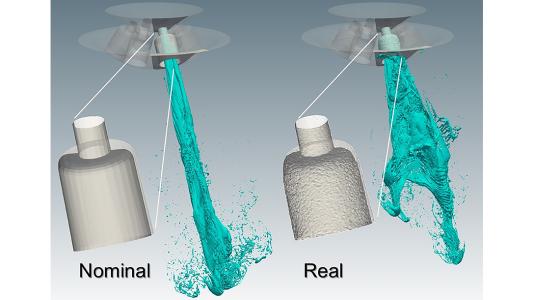
Automotive engineers at Argonne National Laboratory look at systems as complex as vehicle electrification and the charging infrastructure to processes as tiny as the breakup rates of fuel spray droplets. While alternative fueled vehicles continue to be fine-tuned into more affordable and convenient options, researchers are transforming fuel-injected engines into ever leaner combustion systems, which means delivering better fuel economy and emission performance.
One area getting a lot of attention is improving mixture formation, the process by which the fuel injector nozzle breaks up liquid fuel and propels the atomized droplets into engine cylinders. The fuel injector must deliver fuel to the cylinders in just the right pattern, drop size, and volume for an engine to function at its best.
Christopher Powell, principal engine research scientist at Argonne’s Center for Transportation Research, and his team can measure the features inside fuel injectors within two micrometers of accuracy, more precisely than ever before without breaking open the nozzle.
“As emissions regulations get tighter, and squeezing ever more efficiency from engines gets more difficult, knowledge and control of the fuel injection process becomes more important,” said Powell. “The simulations that utilize our measurements have demonstrated that knowing the injector nozzle geometry at the micrometer level is important.”
Argonne research led by Powell suggests that microscopic anomalies introduced during manufacture of spray nozzles significantly impact fuel distribution and combustion efficiency. Powell and his team are examining what happens when engine simulations use the real-world measurements of nozzles instead of optimized design specifications. The results show significant differences in how liquid fuel breaks up into droplets, the size and speed of the droplets, and other features of a fuel spray’s pattern that are crucial for clean, efficient engines.
“When my colleagues simulate fuel spray characteristics using design ideals and compare them to simulations that use real-world measurements, they get far different spray atomization scenarios,” Powell said.
Powell and his team are the first to apply synchrotron X-rays to the study of fuel sprays, taking unprecedented high-resolution CAT scans of injector nozzles and of the sprays themselves. These insights were enabled by use of Argonne’s Advanced Photon Source, a U.S. Department of Energy Office of Science User Facility and home to the world’s only synchrotron X-ray laboratory dedicated to fuel injection research.
More precise fuel spray nozzles will enable new combustion engine strategies that promise significant gains in efficiency, Powell said. “As new manufacturing techniques are adopted, our measurements will continue to be the best, nondestructive way to measure the internal geometries.”
For example, the trend toward turbocharged engines and hybrid electric vehicles means smaller combustion engines. These engines run at higher in-cylinder pressures and temperatures, making preignition, where the fuel ignites before the spark plug fires, more likely. It becomes even more critical to control the fuel injection to get just the right fuel/air mixture.
“In smaller engines, the fuel is more likely to spray on the cylinder walls and the piston, causing increased emissions, deposits, and pre-ignition with a potential for engine damage,” Powell explained. “Here again, it is critical to control the spray, and proper injector design and narrow manufacturing tolerances are key.”
What can manufacturers do? One possibility is to laser drill the nozzle holes. Argonne’s work has shown that the tolerances for laser-drilled nozzles are better than for the traditional electrical discharge machining. In addition, some injector manufacturers are looking at additive, or free-form, manufacturing for making injection nozzles, where parts are created by layering, much as in 3D printing.
“With conventional drilling you can only drill a straight injector nozzle hole,” Powell said. But with additive manufacturing, you could make the hole any shape you want, with bends or right turns, if that is found to improve the fuel injection process. Argonne’s diagnostics and simulations will help in that design process.”
Injector manufacturers will likely need better quality assurance tools than are currently available. While most have X-ray machines to test their parts, they will need images of much finer detail than these machines allow.
Research to address the high-resolution requirements for injector manufacturers and designers will continue.
“We don’t know yet what nozzle attributes are most important for fuel efficiency and in what combinations, so our research continues as we add new knowledge in this area,” Powell said.
The “Effect of Real-World Injector Geometry on Spray Atomization” research at the Center for Transportation of Argonne National Laboratory is funded by the U.S. Department of Energy.